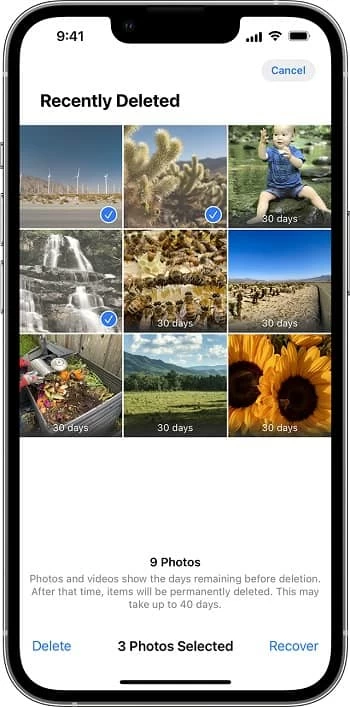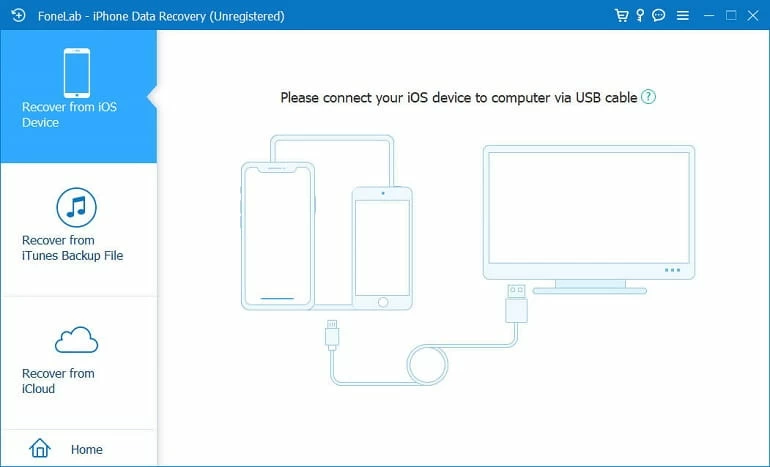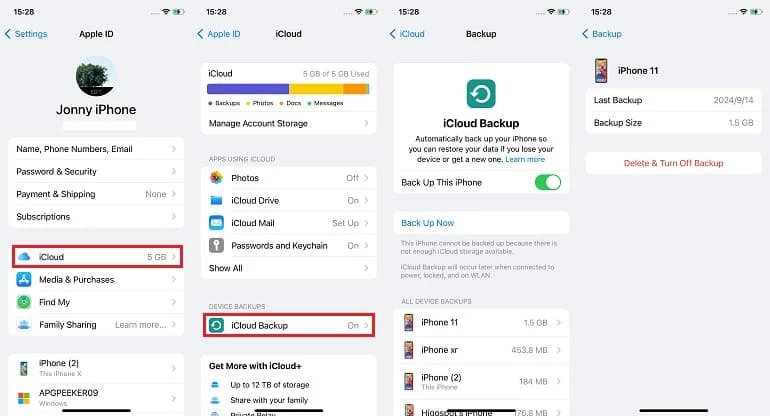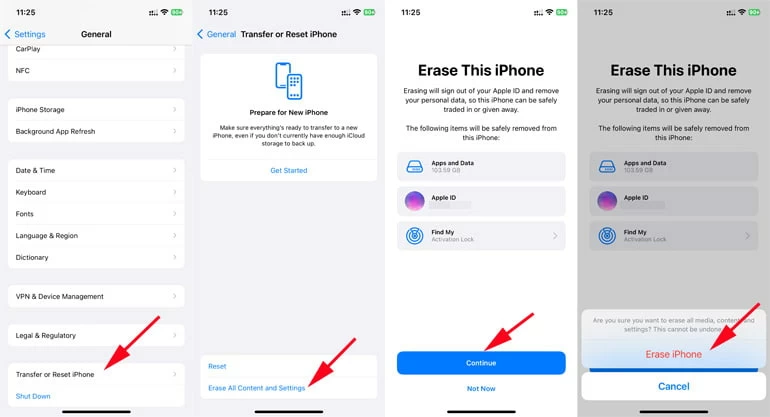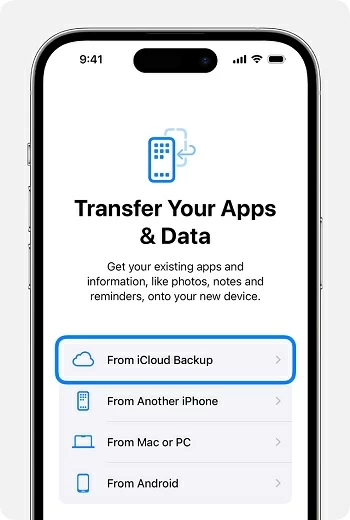How to Recover Deleted Photos on iPhone 14: A Complete Guide
Accidentally deleted photos on your iPhone 14? This in-depth guide provides a full walkthrough on how to get them back, covering all Apple's official methods and powerful iPhone photo recovery tools.

Mark Anderson
Updated on Oct 24, 2025

With a right tool, recovering accidentally deleted photos is a breeze for iPhone 14, 14 Plus, 14 Pro, and 14 Pro Max users.
Accidentally deleting photos is a common issue that many iPhone users may encounter, but the good news is that Apple provides built-in features to help you recover those lost memories. On your iPhone 14, the Recently Deleted album is a lifesaver, offering a straightforward way to recover deleted photos within 30 days. However, if the photos are permanently deleted, recovery becomes more challenging, but not impossible.
Apple offers various methods to recover deleted photos on an iPhone 14, whether they're recently deleted, permanently removed, or you don't have a backup. This guide will walk you through all available iPhone photo recovery options, from Apple's provided tools to third-party solutions.
Whether you're looking to retrieve deleted iPhone 14 photos without a backup, or simply need to restore them after the 30-day window has passed, you'll find step-by-step instructions to get your precious memories back — without the need for complex technical knowledge.
To retrieve deleted photos on iPhone 14 without backup, HigoSpot iPhone Data Recovery offers a reliable solution for full or selective recovery, helping you restore previous memories even when other recovery options fail.
Table of Contents
Part 1: The first 30 Days - "Recently Deleted" Lifesaver
The first and most effective method you should always try is the Recently Deleted album within the Photos app. When you delete a photo from your main Library, it isn't erased from your device's storage immediately. Instead, it's moved to a temporary holding place — the "Recently Deleted" album — for a period of 30 days. This gives you a chance to change your mind and recover the deleted photos on your iPhone 14 effortlessly.
This method works directly from the Photos app, requires no backup to recover the photos deleted from your iPhone 14 within the last 30 days. Here's how:
1. Open the Photos App: Tap the Photos app icon on your iPhone's home screen.
2. Find the "Recently Deleted" Album: Scroll down to the Utilities section and tap Recently Deleted. For older iOS, tap Album at the bottom, and select Recently Deleted under Utilities.
3. Verify Yourself to View Album: For added security, you may be prompted to use Face ID, Touch ID, or your passcode to access this album. Tap View Album and verify.
4. Select and Recover Your Photos:
You will now see a grid of all the photos and videos you have deleted in the last 30 days. Each item has a small countdown in the corner, showing how many days are left until it's gone for good.
- To restore a single photo, tap on it to open it, then tap Recover in the bottom-right corner.
- To restore multiple photos, tap Select in the top-right corner, then tap all the photos you want to recover. Once you're done, tap Recover at the bottom of the screen.
5. Confirm the Photo Recovery: Tap Recover [Number] Photos to move the selected photos back to your Library, where they will reappear as if they were never deleted.

Part 2: The Truth of "Permanent Deletion" - What Happens After 30 Days
When a photo is removed from the "Recently Deleted" album — either manually or automatically after the 30-day period, it's considered "permanently" deleted. However, the data isn't immediately erased; the system simply removes the reference, marking the space as available for new data.
This means the deleted photos can remain on your iPhone 14's storage for an unpredictable period — it could be minutes, hours, or even days — until new data overwrites them. As long as the space hasn't been used, there's still a chance to recover the photos permanently deleted from your iPhone 14, even without a backup.
Part 3: Deep Scan - Recover Deleted Photos on iPhone 14 Without Backup
For situations where no backup is available for deleted photo recovery on your iPhone 14, tools like HigoSpot iPhone Data Recovery offers a direct solution. Engineered to deeply scan your iPhone's internal storage, it can find any recoverable files, including photos, messages, contacts, call logs, notes, and more.
By bypassing the need of a pre-existing backup, this tool can detect and locate both recently and permanently deleted files. You can preview the results and selectively recover your deleted iPhone 14 photos by browsing categories and albums, all without relying on iCloud or computer backups.
Win Download Mac Download
Key features you may like:
- No Backup Required: It works for data recovery if you have no iCloud or iTunes backup.
- Deep Scan: Looking for deleted photos and data files that are no longer visible to the standard iOS storage system.
- Selective Recovery: Unlike Apple's restore process from a backup, it allows you to preview and choose exactly which files for recovery, such as specific photos, messages, or contacts.
- Preview Functionality: Offers a preview of recoverable pictures and files before you commit to the recovery process.
Recover Deleted Photos for iPhone 14, 14 Plus, 14 Pro, or 14 Pro Max, without a Backup:
1. Install and open iPhone Data Recovery on your Mac or PC.
2. Select Recover from iOS Device and connect your iPhone 14 via a USB cable.

3. Click Start Scan for a thorough deep scanning. It may take a short while to locate and load all recoverable photos on your iPhone 14.

4. Select your desired iPhone photos for recovery. You can click each picture you want back or deselect the photos you don't need.
5. Click Recover button.

In the pop-up dialog box, specify a local path and save the recovered photos safely. This way, you're able to recover your permanently deleted iPhone photos even without a backup, and access them anytime you want.

Part 4: Time Machine - Recover Permanently Deleted iPhone 14 Photos from Backup
Once photos are no longer in the Recently Deleted folder or in iPhone's internal hidden storage — whether by maunally or automatically removed — your only official Apple options rely on a backup.
Warning: Restoring from a backup is a complete system reset. It will erase all current data and settings on your iPhone and replace them with the data from the chosen backup. This means that after the photo recovery on iPhone 14, any data you have acquired since the date of that backup, including apps, messages, settings, and new photos, will be permanently lost. So carefully consider whether the photos you want to recover are worth losing your recent data.
Option 1. Retore iPhone 14 Photos from iCloud Backup
If you've been using iCloud Backups, your iPhone automatically backs up data like photos, settings, and app data when connected to Wi-Fi, power, and locked. To use this backup for recovering deleted photos on iPhone 14, Apple requires you to first completely erase your iPhone and then restore it from the iCloud backup during the initial setup process.
Important: Restoring photos from iCloud is an all-or-nothing process—your entire iPhone data will be replaced, and you cannot browse an iCloud backup and select only the photos to restore.
Steps to Restore iPhone 14 Photos from an iCloud Backup:
1. Check for a Usable Backup:
Before you erase your phone, make sure you have a backup that contains the photos you want. Go to Settings > [Your Name] > iCloud > iCloud Backup. Look at the "Last successful backup" date. This date should be before you permanently deleted the photos. If it's a newer backup, the photos will not be included, and you will have reset your phone for nothing.

Note: If iCloud Photos is enabled, your photos won't be backed up to iCloud server but only sync across all your iCloud-joined devices. If so, this method won't be useful to recover your lost photos.
2. Erase Your iPhone:
If you have a suitable backup, proceed with the factory reset. Go to Settings > General > Transfer or Reset iPhone. Tap Erase All Content and Settings. You will be prompted to enter your passcode and Apple ID password to confirm the reset.

3. Restore from iCloud:
After your iPhone has been erased and restarts, follow the on-screen setup prompts. On the Transfer Your Apps & Data screen, select From iCloud Backup. Sign in with your Apple ID and choose the correct backup from the list.

Your iPhone will then begin the long process of downloading the entire backup from iCloud to your iPhone 14, including the photos you've accidentally deleted. This can take several minutes or hours, depending on your Wi-Fi speed and the size of your backup.
Once complete, your iPhone will have the old photos back, but you will need to re-download any apps and data you lost in the process.
Option 2. Restoring Deleted Photos from a Computer Backup (Finder or iTunes)
Apple's official way to get deleted photos back to iPhone 14 from a computer backup is through a full system restore using either Finder (on macOS Catalina and later) or iTunes (on older macOS versions and Windows). When you back up your iPhone to a computer, it saves a snapshot of nearly all your device's data and settings, including the pictures and videos in Photos Library.
However, Apple doesn't allow you to selectively pull just the photos from the backup. Instead, it restores the entire backup to your iPhone 14 for deleted photo recovery and reverts your device to the exact state it was in when the backup was made.
Steps for Recovering iPhone 14 Photos from a Computer Backup:
1. Connect Your iPhone: Use a USB cable to connect your iPhone 14 to your computer (Mac or PC) where you have a backup. Ensure that the Find My iPhone is disabled before the process.
2. Open Finder or iTunes:
- On a Mac with macOS Catalina 10.15 or newer, open a Finder window.
- On a PC or a Mac with macOS Mojave 10.14 or older, open iTunes.
3. Select Your iPhone: Click your iPhone when it appears in the Finder sidebar or iTunes window.
4. Initiate Restore:
- In Finder, under the "General" tab, click Restore Backup.
- In iTunes, on the "Summary" screen, click Restore Backup.
5. Choose the Correct Backup: A list of backups will appear. Choose the one that was created before you deleted the photos. If your backup is encrypted, enter the correct password to unlock it.
6. Confirm and Restore: Click Restore and wait for the photo recovery process to finish on your iPhone 14. Do not disconnect it until the restore is complete.

Part 5: After Recovery - Preventing Future Data Loss on Your iPhone
Congratulations! If you've successfully recovered your deleted iPhone 14 photos, don't let your hard work go to waste. Take these immediate steps to safeguard your memories for the future.
1. Back Up Your iPhone 14 Immediately
The first thing you should do is create a brand new, up-to-date backup. This ensures that your newly recovered photos, along with all your current data, are safe.
- iCloud: Go to Settings > [Your Name] > iCloud > iCloud Backup and tap "Back Up Now."
- Computer: Connect your iPhone to Mac or PC and perform a manual backup using Finder or iTunes.
2. Organize Your Photos
The recovered photos will be back in your iPhone 14's Camera Roll or albums according to their original date. Scroll back to find them and consider creating a new album to keep them organized and easy to find.
3. Re-evaluate Your Backup Strategy
This incident is a powerful lesson in the importance of backups. Now is the perfect time to create a robust, automatic backup system.
- Enable Automatic iCloud Backup: Go to Settings > [Your Name] > iCloud > iCloud Backups and make sure the toggle is on. Your iPhone will now automatically back up everything when it's connected to power, Wi-Fi, and is locked.
- Turn on iCloud Photos: This is different from iCloud Backup. iCloud Photos syncs your entire Photo Library across all your Apple devices and stores it in iCloud. If you delete a photo on one device, it deletes everywhere, but it offers the same 30-day "Recently Deleted" safety net on iCloud.com as well. It's an excellent way to keep your photos safe and accessible.
- Consider a Redundant Backup: Use iCloud Photos and also periodically back up your iPhone to a computer. You might also use a third-party service like Google Photos or OneDrive as an additional cloud backup.
By following this guide, you have the best possible chance of recovering your cherished photos and, more importantly, the knowledge to prevent this kind of stress from happening again.
FAQs
- Where do deleted photos go on iPhone 14?
- When you delete a photo on your iPhone 14, it moves to the "Recently Deleted" album in the Photos app. It stays there for 30 days, giving you a chance to recover it before it's permanently erased.
- Can I recover permanently deleted photos on my iPhone 14?
- It is difficult, but often possible. Once a photo is permanently deleted (after 30 days in the "Recently Deleted" album), it's no longer accessible through standard Apple methods. Your best option is to use a third-party data recovery tool like iPhone Data Recovery that can deep-scan the iPhone's memory for data fragments that haven't been overwritten yet.
- Is it possible to retrieve my deleted photos if I don't have a backup?
- Yes, it is possible. You won't be able to use iCloud or iTunes backup methods, so you may need rely on a third-party data recovery tool. These programs are designed to scan your iOS device's internal storage and attempt to recover data directly from the iPhone itself.


About Mark Anderson
Mark is a passionate content creator with years of experience in technical field. He has written a variety of niches and always shares a unique insight into the world of Internet & technology.
 iPhone UnlockerRemove iPhone & iPad lock screen
iPhone UnlockerRemove iPhone & iPad lock screen iPhone Data TransferTransfer and manage your iPhone & iPad data
iPhone Data TransferTransfer and manage your iPhone & iPad data Android UnlockerRemove Google FRP lock and bypass screen locks
Android UnlockerRemove Google FRP lock and bypass screen locks iPhone Data RecoveryRecover deleted files from iPhone, iPad
iPhone Data RecoveryRecover deleted files from iPhone, iPad Location ChangerFake a GPS location easily
Location ChangerFake a GPS location easily Video DownloaderDownload videos from 1000+ sites
Video DownloaderDownload videos from 1000+ sites

